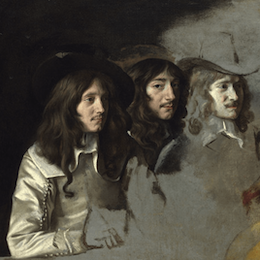Antoine, Louis et Mathieu Le Nain
entre 1597 et 1607 (Laon) / entre 1648 et 1677
Originally from Laon in Picardy, trained perhaps with a painter from the Haarlem household, and remaining attached to their land - and therefore more sensitive to the Nordic aesthetic than Valentin could have been - the three Le Nain brothers, Antoine the elder, Mathieu and Louis the youngest, set up their workshop in Paris in 1629 near the Flemish milieu, in the enclosure of the abbey of Saint-Germain-des-Prés. Although Antoine was the head of the studio and his two brothers were mere companions, they signed their paintings with the sole name of "Lenain", as if they were a firm. Even if they executed large religious decorations for the Petits-Augustins convent or for Notre-Dame de Paris, and if a portrait - now disappeared - of Anne of Austria painted by them is reported, the Le Nains were above all addressing a public of well-off bourgeois, much less highly placed than the king, the court and the powerful financiers for whom Simon Vouet was working at the same time. It was the taste of these bourgeois dreaming of being gentlemen that explains the irruption of inimitable peasant representations.
Visual:
Louis le Nain
Peasant family.
About 1642, oil on canvas, 1.13 x 1.59 cm.
Musée du Louvre, Paris.
RMN-Grand Palais (Musée du Louvre) / Jean-Gilles Berizzi
Originally from Laon in Picardy, trained perhaps with a painter from the Haarlem household, and remaining attached to their land - and therefore more sensitive to the Nordic aesthetic than Valentin could have been - the three Le Nain brothers, Antoine the elder, Mathieu and Louis the youngest, set up their workshop in Paris in 1629 near the Flemish milieu, in the enclosure of the abbey of Saint-Germain-des-Prés. Although Antoine was the head of the studio and his two brothers were mere companions, they signed their paintings with the sole name of "Lenain", as if they were a firm. Even if they executed large religious decorations for the Petits-Augustins convent or for Notre-Dame de Paris, and if a portrait - now disappeared - of Anne of Austria painted by them is reported, the Le Nains were above all addressing a public of well-off bourgeois, much less highly placed than the king, the court and the powerful financiers for whom Simon Vouet was working at the same time. It was the taste of these bourgeois dreaming of being gentlemen that explains the irruption of inimitable peasant representations.
Visual:
Louis le Nain
Peasant family.
About 1642, oil on canvas, 1.13 x 1.59 cm.
Musée du Louvre, Paris.
RMN-Grand Palais (Musée du Louvre) / Jean-Gilles Berizzi
Artist's exhibitions
Le mystère des frères Le Nain
22/03/2017 - 26/06/2017
(Lens) Musée du Louvre-Lens
22/03/2017 - 26/06/2017
(Lens) Musée du Louvre-Lens
